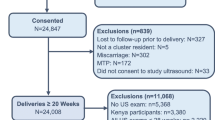Abstract
Purpose
As conflicting data exist concerning the implications of isolated oligohydramnios on pregnancy outcome at term, we aimed to assess this association in low-risk pregnancies.
Methods
A retrospective cohort study of term pregnancies with sonographic finding of isolated oligohydramnios (amniotic fluid index (AFI) <5 cm) between 2007 and 2012. Outcome was compared to a control group of pregnancies with normal AFI (5–25 cm). Pregnancies complicated by thrombophilia, hypertension, diabetes, deviant fetal growth or chromosomal/structural abnormalities were excluded. Composite adverse outcome included CS/operative delivery due to non-reassuring heart rate (NRFHR), low Apgar score, umbilical artery pH < 7.10, neonatal intensive care admission, meconium aspiration syndrome, intubation or hypoxic-ischemic encephalopathy.
Results
Overall, 987 pregnancies complicated by isolated oligohydramnios were compared to 22,280 low-risk pregnancies with normal AFI. Isolated oligohydramnios was associated with a higher rate of induction of labor (27.7 vs. 3.7 %, p < 0.001), CS due to NRFHR (2.3 vs. 1.1 %, p < 0.01) and composite adverse outcome (9.7 vs. 7.1 %, p < 0.01). However, after adjusting for potential confounders as induction of labor and nulliparity using multivariable logistic regression analysis, isolated oligohydramnios was not found to be independently associated with increased risk for composite adverse outcome (OR 1.01, 95 % CI 0.80–1.27, p = 0.93).
Conclusion
Isolated oligohydramnios at term by itself is not associated with increased obstetrical morbidity.

Similar content being viewed by others
References
Hill LM, Breckle R, Wolfgram KR, O’Brien PC (1983) Oligohydramnios: ultrasonically detected incidence and subsequent fetal outcome. Am J Obstet Gynecol 147:407–410
Mercer LJ, Brown LG, Petres RE, Messer RH (1984) A survey of pregnancies complicated by decreased amniotic fluid. Am J Obstet Gynecol 149:355–361
Chauhan SP, Sanderson M, Hendrix NW, Magann EF, Devoe LD (1999) Perinatal outcome and amniotic fluid index in the antepartum and intrapartum periods: a meta-analysis. Am J Obstet Gynecol 181(6):1473–1478
Baron C, Morgan MA, Garite TJ (1995) The impact of amniotic fluid volume assessed intrapartum on perinatal outcome. Am J Obstet Gynecol 173(1):167–174
Ghosh G, Marsal K, Gudmundsson S (2002) Amniotic fluid index in low-risk pregnancy as an admission test to the labor ward. Acta Obstet Gynecol Scand 81:852–855
Zhang J, Troendle J, Meikle S, Klebanoff MA, Rayburn W (2004) Isolated oligohydramnios is not associated with adverse perinatal outcomes. BJOC 111:220–225
Magann EF, Chauhan SP, Dohorty DA, Barrilleaux S, Martin JN Jr, Morrison JC (2003) Predictability of intrapartum and neonatal outcomes with the amniotic fluid volume distribution: a reassessment using amniotic fluid index, single deepest pocket, and a dye-determined amniotic fluid volume. Am J Obstet Gynecol 188(6):1523–1527
Chauhan SP, Cowan BD, Magann EF, Roberts WE, Morrison JC, Martin JN Jr (1996) Intrapartum amniotic fluid index. A poor diagnostic test for adverse perinatal outcome. J Reprod Med 41(11):860–866
Chauhan SP, Hendrix NW, Morrison JC, Maggan EF, Devoe LD (1997) Intrapartum oligohydramnios does not predict adverse peripartum outcome among high risk parturients. Am J Obstet Gynecol 176(6):1130–1136
Rossi AC, Prefumo F (2013) Perinatal outcomes of isolated oligohydramnios at term and post-term pregnancy: a systematic review of literature with meta-analysis. Eur J Obstet Gynecol Reprod Biol 169(2):149–154
Conway DL, Adkins WB, Schroeder B, Langer O (1998) Isolated oligohydramnios in the term pregnancy: is it a clinical entity? J Matern Fetal Med 7:197–200
Manzanares S, Carrillo MP, González-Perán E, Puertas A, Montoya F (2007) Isolated oligohydramnios in term pregnancy as an indication for induction of labors. J Matern Fetal Neonatal Med 20(3):221–224
Rainford M, Adair R, Scialli AR, Ghidini A, Spong CY (2001) Amniotic fluid index in the uncomplicated term pregnancy. Prediction of outcome. J Reprod Med 46(6):589–592
Nabhan AF, Abdelmoula YA (2008) Amniotic fluid index versus single deepest vertical pocket as a screening test for preventing adverse pregnancy outcome. Cochrane Database Syst Rev 3:CD006593
Dollberg S, Haklai Z, Mimouni FB, Gorfein I, Gordon ES (2005) Birth weight standards in the liveborn population in Israel. Isr Med Assoc J 7:311–314
Casey BM, McIntire DD, Bloom SL, Lucas MJ, Santos R, Twickler DM, Ramus RM, Leveno KJ (2000) Pregnancy outcomes after antepartum diagnosis of oligohydramnios at or beyond 34 weeks’ gestation. Am J Obstet Gynecol 182(4):909–912
Robson SC, Crawford RA, Spencer JA, Lee A (1992) Intrapartum amniotic fluid index and its relationship to fetal distress. Am J Obstet Gynecol 166(1 Pt 1):78–82
Jeng CJ, Lee JF, Wang KG, Yang YC, Lan CC (1992) Decreased amniotic fluid index in term pregnancy. Clinical significance. J Reprod Med 37(9):789–792
Magann EF, Chauhan SP, Kinsella MJ, McNamara MF, Whitworth NS, Morrison JC (1999) Antenatal testing among 1001 patients at high risk: the role of ultrasonographic estimate of amniotic fluid volume. Am J Obstet Gynecol 180(6 Pt 1):1330–1336
Locatelli A, Vergani P, Toso L, Verderio M (2004) Perinatal outcome associated with oligohydramnios in uncomplicated term pregnancies. Arch Gynecol Obstet 269(2):130–133
Ghidini A, Spong CY (2001) Severe meconium aspiration syndrome is not caused by aspiration of meconium. Am J Obstet Gynecol 185(4):931–938
Elsandabesee D, Majumdar S, Sinha S (2007) Obstetricians’ attitudes towards ‘isolated’ oligohydramnios at term. J Obstet Gynaecol 27(6):574–576
Conflict of interest
None declared.
Author information
Authors and Affiliations
Corresponding author
Rights and permissions
About this article
Cite this article
Ashwal, E., Hiersch, L., Melamed, N. et al. The association between isolated oligohydramnios at term and pregnancy outcome. Arch Gynecol Obstet 290, 875–881 (2014). https://doi.org/10.1007/s00404-014-3292-7
Received:
Accepted:
Published:
Issue Date:
DOI: https://doi.org/10.1007/s00404-014-3292-7



